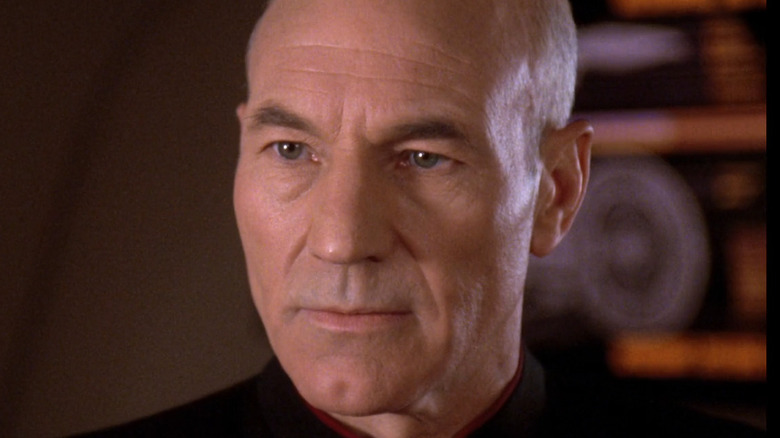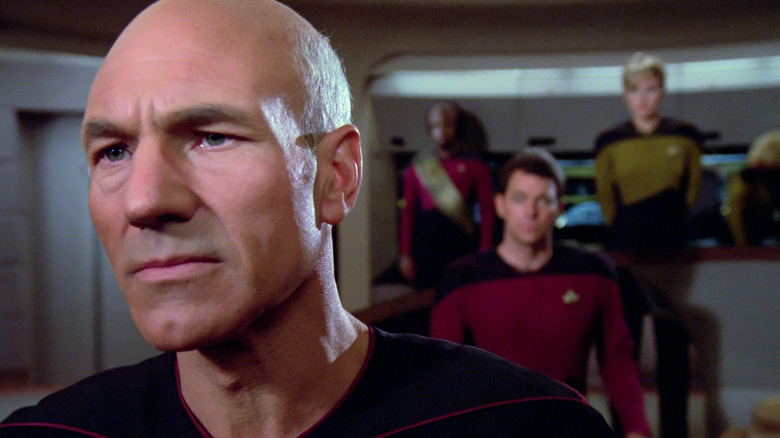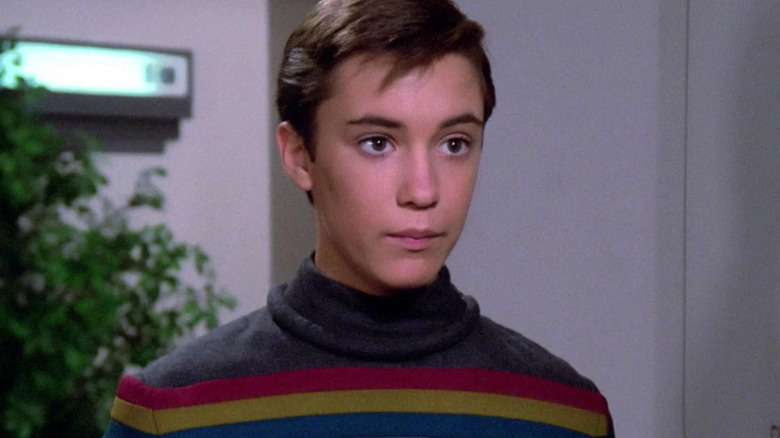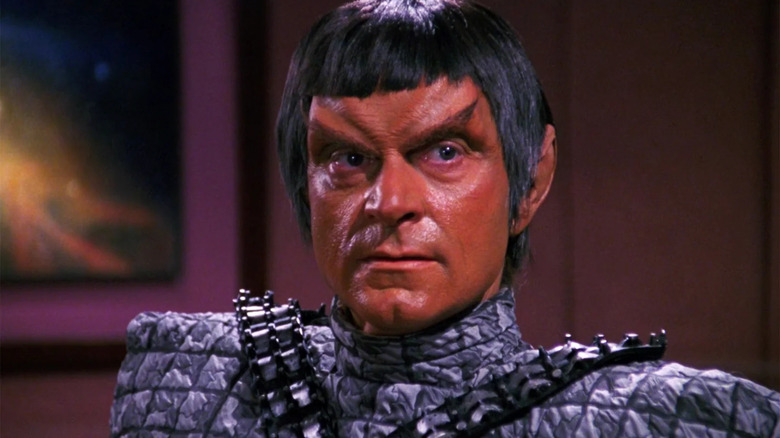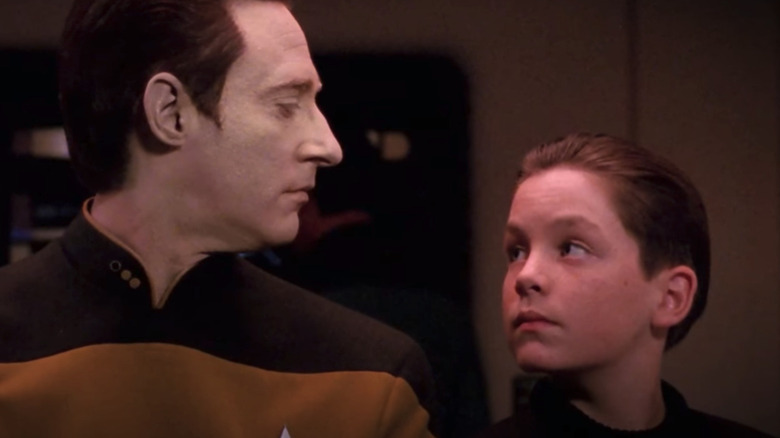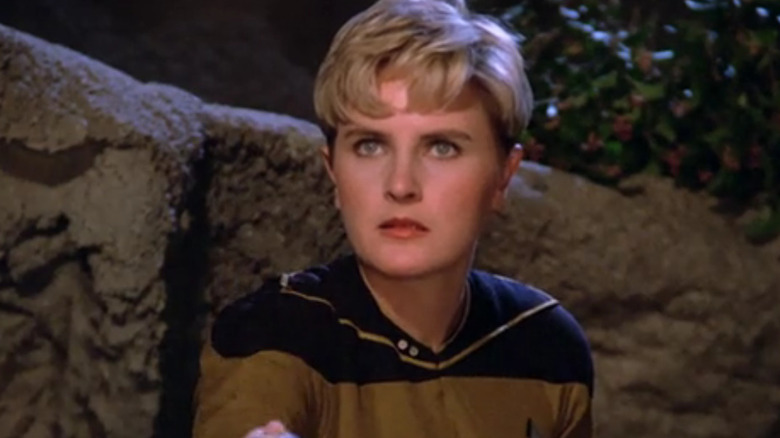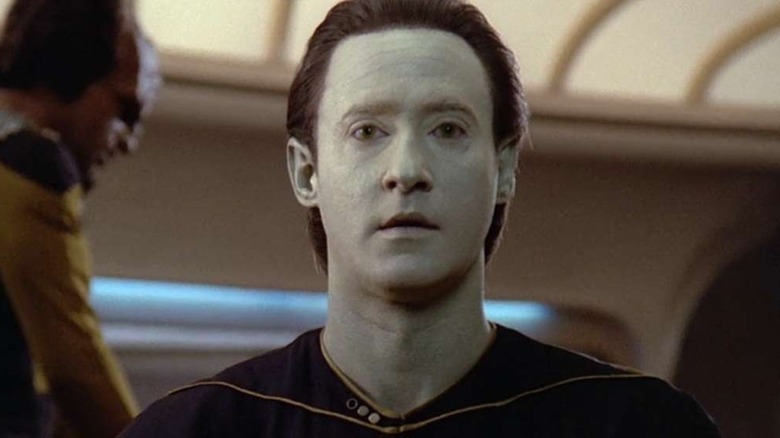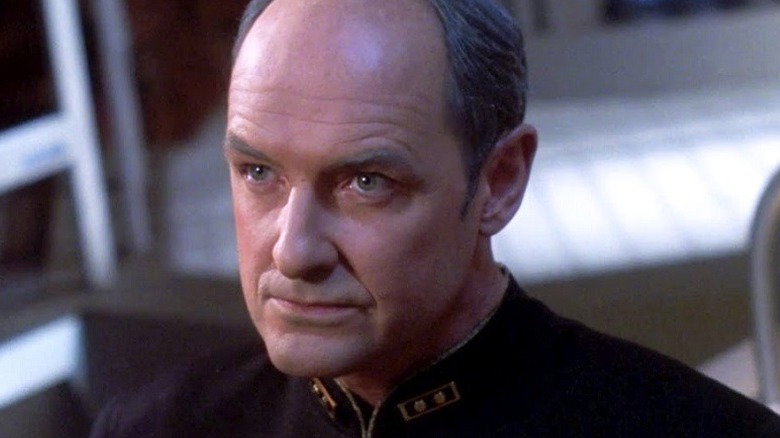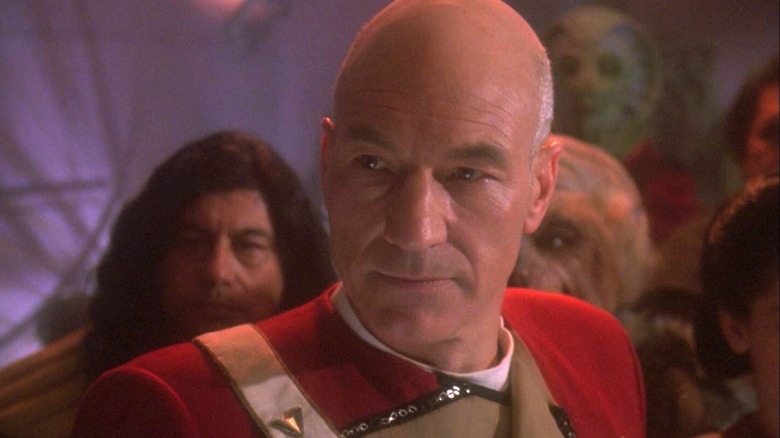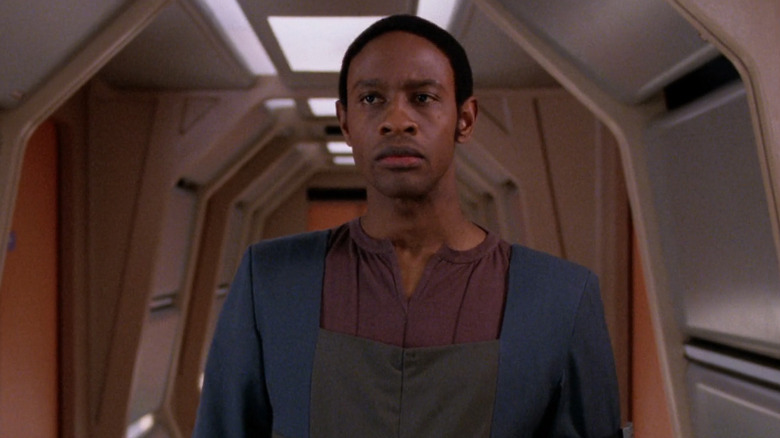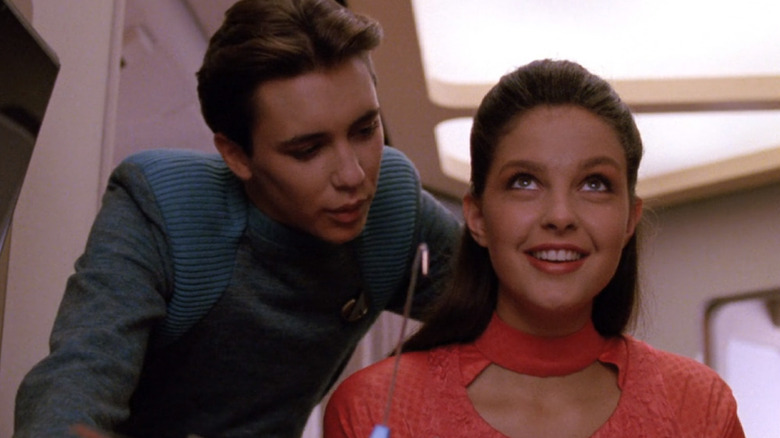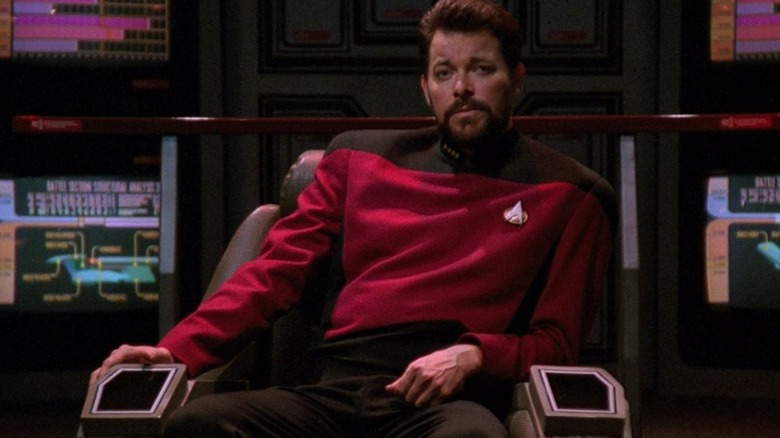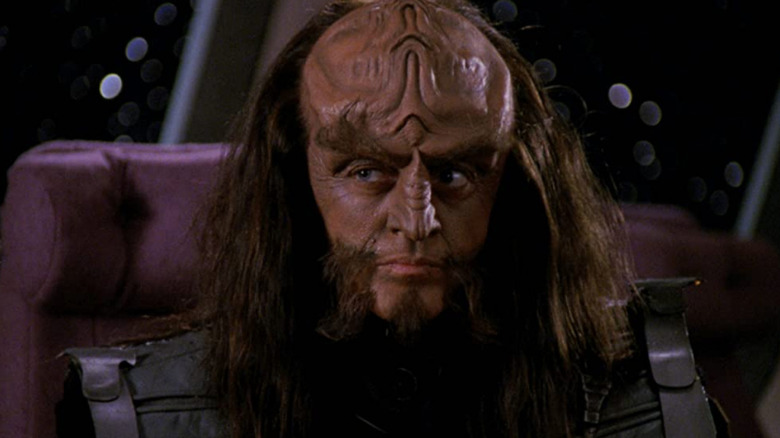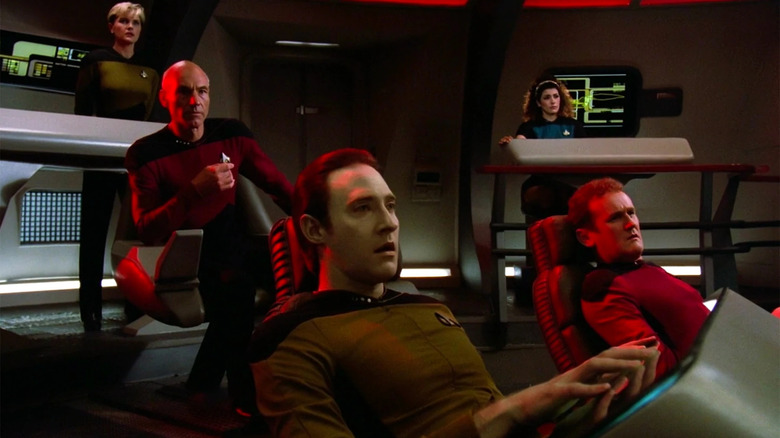Things You Only Notice In Star Trek: The Next Generation After Watching It More Than Once
It may be tough for some to remember, but when "Star Trek: The Next Generation" first aired on television in 1987, it was both controversial and not expected to be a big hit after some scathing early reviews. Today, of course, the series is remembered as one of the greatest science fiction TV shows ever made, full of dramatic stories that dispensed thought-provoking wisdom. A series as much about exploring its characters as exploring the galaxy, it captivated audiences for the better part of a decade.
Over the years, "Star Trek: The Next Generation" has amassed a passionate fan following, and it even received a follow-up series more than 30 years later in "Star Trek: Picard." But if you've only seen the series one time, you may be missing a lot of what makes it great, many of its quirks, and even a few of its flaws. So step onto the transporter pad and double-check that your tricorder is operational, because we're going back to "Star Trek: The Next Generation" to highlight things you only notice when you've seen it more than once.
Those Season 1 jitters
Putting aside how lackluster Season 1 of "Star Trek: The Next Generation" is — arguably the worst first season in "Star Trek" history — a rewatch of the show illuminates just how different it was when it first launched. In addition to several key cast changes made in its second year, the show's tone is drastically different in Season 1 as well.
It's well documented that the early years of the show had a merry-go-round of writers, and the results are an off-kilter mish-mash. In fact, Season 1 is more of an action-adventure than you might expect, and some of the characters are nearly unrecognizable from their later selves. Deanna Troi is often a ball of weeping emotion, far from the steadfast advisor she becomes, while the robotic Commander Data displays more flashes of emotion than you probably remember. Clearly, the show hadn't quite figured out how to characterize him.
Likewise, the younger Lt. Worf isn't yet the first-rate Klingon warrior he's later shown to be, and his legendary bat'leth weapon is nowhere to be seen. Suffice it to say, a second sit-down with "TNG" Season 1 will reveal an almost entirely different show, but the sparks of its greatness still shine through from time to time.
Wesley isn't really that bad
Nobody would ever argue that prophesied child genius Wesley Crusher is one of the best characters on "The Next generation," but his reputation as a reviled black mark on the show is undeserved. A second watch of the series reveals that Wesley isn't quite as bad as you might remember. Instead, you may realize that most of his cringe-worthy moments and groan-inducing episodes are simply a result of the woeful first season, where pretty much everything falls short.
It's pretty easy in retrospect to overlook Season 1 episodes like "Justice" and "When the Bough Breaks," not to mention his contributions to episodes like "The Naked Now." All of these poorly-received stories are flawed at a fundamental level, and like just about everything in the series, Wesley gets better material to work with as the show progresses. He's even central to a few of the most underrated "Star Trek: The Next Generation" episodes, including Season 3's "The Game" and "Final Mission" and the outstanding coming-of-age courtroom drama "The First Duty."
Even his strange Season 1 costume hides a fun little detail you may have missed on the first watch. The simple rainbow stripe may seem odd at first, but it's actually a combination of all three Starfleet uniform colors. This denotes the fact that as an "acting ensign," he hasn't been assigned a division yet.
Ongoing storylines
For a series that aired in an era of the strict episodic format — where serialized stories were reserved only for soap operas — "Star Trek: The Next Generation" has a surprising number of ongoing storylines that you might not notice the first time through.
Data's quest to become more human, for example, weaves its way through the whole series, with the first mention coming in the series premiere. Later episodes show the android commander finding ways to explore his own humanity through music, theater, art, and even experimenting with a romantic relationship. Meanwhile, episodes like "Inheritance" and "Silicon Avatar" call back to his earlier established origins on the planet Omicron Theta.
Brewing political tensions with the Romulans surface in the Season 1 finale "The Neutral Zone," and they pop up several more times before culminating in the Season 4 cliffhanger "Redemption." This storyline later plays a central role in the two-part story with Mr. Spock in "Unification." Captain Picard's own character arc sees him soften from the cold, dispassionate captain he is at first, and his dislike of children — established early on — slowly melts away. He even embraces the prospect of being a father in "Bloodlines."
Despite the notion that "The Next Generation" is entirely episodic, there are plenty of ongoing plot threads and character arcs that become more apparent on a second viewing.
Plots are repeatedly recycled
Some say that there are only so many stories that can be told, though the number varies depending on who you ask. In re-watching "Star Trek: The Next Generation," you're likely to notice some story premises that strike a very similar tone, even down to some of the same exact plot beats.
A calamity that strikes the ship while one or more members of the crew are away on a separate mission — only to return to find the Enterprise in dire straits — is a trope used more than once. Most notably, it pops up in "Timescape" and "Genesis," which both see Picard return to the ship to discover the crew in the throes of disaster. Too many episodes to count kick off with the ship coming to the aid of a missing or damaged Starfleet vessel, or getting dragged into a conflict on an alien world that doesn't involve them.
But the most overused plot is easily the surrogate parent story. Episodes like "Suddenly Human," "New Ground," "Future Imperfect," "The Bonding," and "Hero Worship" all have such identical stories that you'd be forgiven if you couldn't tell them apart at times. Each one features a member of the crew reluctantly taking on a parental role, usually to an orphaned little boy. You might not notice it the first time through, but after a rewatch, it's definitely eyebrow-raising how common the trope becomes.
The crew has dark backstories
Modern "Star Trek" shows like "Discovery" and even the "TNG" sequel series "Picard" have been accused by some of being overly dark, with too many characters haunted by tragic pasts. But while "The Next Generation" may be a more upbeat series than some modern incarnations, its cast of characters has surprisingly dark backstories you might not have noticed the first time through.
Though we don't get all the details right out of the gate, the Klingon Lt. Worf is revealed to have been raised by humans after his parents were killed in a Romulan sneak attack when he was a child. This tragedy eventually shapes his entire character. Commander Data was likewise rescued by Starfleet after a deadly attack on his home colony by an alien entity that killed thousands, while Lt. Yar escaped harsh conditions on a remote colony in her youth. In fact, Yar's story is so grim it almost feels out of place, with decidedly un-family-friendly mentions of gangs that preyed on women on her homeworld.
Later on, we meet Guinan, the El-Aurian bartender whose own planet was obliterated by the Borg, scattering her people throughout the galaxy. We're also introduced to Ensign Ro, a Bajoran who spent her childhood amid the brutality of the Cardassian Occupation of Bajor. Add these all together, and you'll realize "TNG" is littered with haunted characters from the beginning.
Data is a deadly, life-saving plot device
Following the precedent set by the original "Star Trek" with Mr. Spock, the new Enterprise in "The Next Generation" has Commander Data, a super smart, emotionless officer and confidante of the ship's captain. Early in the show's run, he's the outsider character, providing fresh perspective on unique situations. Because he doesn't fully understand humanity, he's also often a source of comic relief.
But with his superior positronic brain and incredible android abilities, the writers quickly realized Data could be a plot device too. When the rest of the crew find themselves in tough spots, Data can rescue them with his superhuman strength, lightning-fast reflexes, his ability to tap into the ship's computers, and even his natural immunity to disease. In short order, Data becomes a living deus ex machina — the only one with the ability to save the day in a critical situation. This happens in episodes like "Cause and Effect," "Disaster," "Night Terrors," "The Game," and in the famous cliffhanger "The Best of Both Worlds."
But if you've watched "TNG" enough times, you'll also notice that the show uses him as an insidious danger to the ship and its crew too. Twice in the episodes "Brothers" and "Descent," a hidden program prompts him to take control of the Enterprise, while in "A Fistful of Datas," a malfunction on the holodeck turns him into a dangerous villain who threatens the Enterprise.
Starfleet has a lot of bad eggs
Even by the time "Star Trek: The Next Generation" began airing in 1987, the franchise had long been portraying Starfleet and the Federation as the bastions of righteousness in the galaxy. Both organizations are said to embody the best that humanity can be — helping those in need, furthering the cause of peace between worlds, and serving as a shining example to the galactic community of what can be achieved through mutual cooperation. Yet, on a rewatch of "TNG," it becomes clear that there may be more evil admirals in Starfleet than good ones.
It's not just the obviously corrupt Admiral Pressman, who violates the treaty with the Romulans in "The Pegasus." From the very first admirals we meet in Season 1, it's almost as if immorality and dishonor are requirements for the high-ranking position. Admiral Jameson in "Too Short a Season" is revealed to have supplied weapons to terrorists, while Admiral Kennelly secretly allies himself with a group of malevolent Cardassians in "Ensign Ro." It doesn't stop there either, as Admiral Haftel betrays every one of Starfleet's ideals by ordering Data to surrender his daughter to the state.
In fairness, "Badmirals," as they've been dubbed, are not exclusive to "TNG." Some of the worst appear elsewhere in the franchise, but when you watch the series again, you'll realize that "The Next Generation" is where the trend really took off.
Clever foreshadowing
Like any good long-running series, "Star Trek: The Next Generation" does a fair bit of clever storytelling that hints at what's to come. But if you're not paying close attention, it's easy to miss these bits of foreshadowing. Sometimes the hints take years to pay off, only becoming apparent after you've watched the series through more than once.
For example, in "Coming of Age," Captain Picard reveals that he has an artificial heart, describing a fight with Nausicaans in his youth that got him impaled in the back. The conversation is only a side note to the main story, but in Season 6, the incident forms the basis for the episode "Tapestry." The writers surely didn't plan the episode years ahead of time, but it's a nice bit of continuity for Picard's backstory.
Similarly, the incident that sparks the Season 1 finale "The Neutral Zone" is the mysterious destruction of a remote Federation colony, revealed two years later to have been the work of The Borg. And then of course there's Guinan, who tells Geordi in the Season 3 episode "Booby Trap" that she's attracted to bald men because "a bald man was very kind to me once." It takes time, but this tidbit is paid off in the Season 5 cliffhanger "Time's Arrow" when a time-traveling Picard saves her life more than four hundred years in the past.
Future regulars are all over the place
It's true that "Star Trek" often re-casts actors as multiple characters, with "Re-Animator" star Jeffrey Combs playing no less than three iconic roles in the franchise. But when rewatching "The Next Generation," you might be surprised to discover several future "Star Trek" series regulars popping up in minor roles. And no, we're not talking about Colm Meaney or Rosalind Chao, whose characters on "TNG" moved over to "Deep Space Nine."
It starts quite early on, with Armin Shimmerman playing the Ferengi Letek in the series' fifth episode, "The Last Outpost." Shimmerman played a couple of other small roles on "TNG" before joining the cast of "DS9" in 1993 as the Ferengi bartender Quark. "Voyager" star Tim Russ guest stars as a thief in the Season 6 episode "Starship Mine," while his future co-star Ethan Philips, who plays Neelix, turns up as a Ferengi in "Ménage à Troi." Similarly, Max Grodénchik — who later starred as Rom on "DS9" — plays a scheming Ferengi scoundrel in "Captain's Holiday," while Gul Dukat himself, Marc Alaimo, turns up as a different Cardassian in "The Wounded" and as a French card player in "Time's Arrow."
Most interesting, though, is Robert Duncan McNeill, who later played Lt. Tom Paris in "Star Trek: Voyager." McNeill plays disgraced Starfleet cadet Nick Locarno in the "TNG" episode "The First Duty," who wound up serving as the inspiration for the Tom Paris character (per Entertainment Tonight).
Starfleet members before they were stars
On your first time watching through "Star Trek: The Next Generation," it's possible you didn't notice the number of big-name stars who show up in small roles. Some of them have major guest roles, while a few only get a line or two of dialogue. On a more relaxed rewatch, it's easier to spot them.
Ashley Judd made her screen debut in the background of the episode "Darmok," and she's a lot more prominent in the later episode "The Game." If you weren't watching closely, you might not have recognized Teri Hatcher, five years before she was cast as Lois Lane in "Lois and Clark: The New Adventures of Superman." She shows up in a 1988 episode titled "The Outrageous Okona" as Lt. Robinson, but that's hardly the end of the Hollywood star-walk.
Future "The Drew Carey Show" actor Diedrich Bader plays an unnamed officer in the episode "The Emissary." A bit later in the series, a young Kirsten Dunst appears in the episode "Dark Page" just a year before her breakout performance in "Interview with the Vampire." A few years earlier, future "X-Men" star Famke Janssen also starred opposite Patrick Stewart in the Season 3 episode "The Perfect Mate," where she plays the mutant mind-reader Kamala.
Riker's odd mannerisms
Who doesn't love William T. Riker? A stalwart first officer, he's the perfect mix of endearing charm and commanding presence, and it's hard not to see why he's a fan favorite. He can fire his phasers at an attacking enemy vessel, shrug off a volley of photon torpedoes, stand up to the most diabolical enemies of the Federation, and do it all with a smile and a twinkle in his eye. But if you watch "The Next Generation" a couple of times, you'll start to notice some of his odd physical quirks.
Most famous is the strange way he sits down in chairs, with a swing of his leg over the seat back that's since become something of a meme. When a fan put together a supercut of the move, it caused such an uproar that it was covered by The Hollywood Reporter. But it's hardly the only odd physical mannerism that Riker has.
Watch "TNG" enough and you'll notice that when he's in the captain's chair, he always sits with a noticeable lean, which he often favors when standing as well. Apparently, it's not just a fun little quirk, but the result of an old back injury actor Jonathan Frakes suffered during a furniture-moving job. This is according to an anonymous commenter on Reddit, whose claim was later confirmed by co-star Wil Wheaton.
Continuity goofs
As much attention as "Star Trek" has always paid to continuity — and usually done a good job — repeated screenings of "The Next Generation" will highlight a few times the show fouled up. Even in such a great series, there are still moments when it feels like the writers simply forgot the events of a previous episode.
Sometimes it's the details. Commander Data is established as unable to use contractions in a late Season 1 installment, but numerous earlier episodes show him doing just that. But there are bigger contradictions too, like Klingon Chancellor Gowron stating that women cannot sit on their High Council, despite having once offered a seat to Worf's girlfriend K'Ehleyr. Then there are the Borg, who are established in their first appearances as having no gender and no interest in anything but technology. However, later retcons completely reshape the Borg into zombie-like villains who "assimilate" existing beings and are very much interested in humans.
Easy to overlook on a first watch, these continuity failures stick out on repeat viewings.
Reused sets and props
Once you've seen "Star Trek: The Next Generation" all the way through, a rewatch can yield some eye-opening moments. One such revelation is the cleverness of the production, and how just about any set or prop can pop up in the most unexpected of places. Most likely just a cost-saving measure, the series always finds ways of recycling elements to create something new each week. Of course, it's harder to hide when you've seen every episode multiple times.
In fact, the recycling of sets and props is so pervasive, that entire websites, blogs, and Twitter accounts have been created by diehard fans to catalog as many instances as can be found. Most notable is that many elements of the Enterprise itself are simply re-dressed versions of the Captain Kirk Enterprise created for the 1980s feature films. The bridge became the Enterprise-D's battle bridge, which later became the bridge of the Enterprise-C, and the Stargazer.
Numerous props, models, and even uniforms throughout the series found different uses too. A pervasive trend throughout the franchise, this might be most noticeable in "TNG" thanks to it being the only '90s series to receive an HD remaster.
